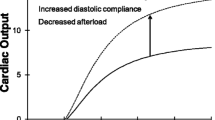Abstract
Left ventricular systolic stiffness was measured by rapidly changing ventricular volume (within 7 ms) of isovolumically contracting isolated rabbit hearts. Instantaneous pressure-volume relations were found to be linear with slopes that depended upon the moment during contraction at which the volume change was induced. These slopes were proportional to the total pressure developed in the ventricle just prior to the volume change. The same was found when the time course of pressure was influenced by changing the Ca++ content of the perfusate. An influence, however, also could be detected when end-diastolic volume was changed. At the same pre-release pressure a greater volume caused a decrease of active stiffness. The results indicate the possiblity of an active component in ventricular systolic stiffness.
Similar content being viewed by others
Abbreviations
- Nr.:
-
number of experiment
- H.W.:
-
heart weight (g)
- EDP:
-
enddiastolic pressure (mm Hg)
- \(\frac{{{\text{Ca}}^{{\text{ + + }}} :}}{{\Delta P/\Delta {\text{V:}}}}\) :
-
Ca++-content of the perfusate (mEq/l) mean value of stiffness in systole in the part of pressure curve which was explored (mm Hg/ml)
- N :
-
number of different times during systole at which QVR were applied
- P max :
-
maximal pressure of the undisturbed pressure curve (mm Hg)
- ΔV0 :
-
inverted slope of the stiffness-pressure relations (ml)
- SEM:
-
standard error of the mean in ΔV0
- \(\frac{{\Delta P}}{{\Delta V}}\left( {{\text{P}}_{\text{2}} = 0} \right)\) :
-
intercept on ΔP/ΔV axis of the stiffness pressure relation (mm Hg/ml)
- SEE:
-
standard error of the estimate in\(\frac{{\Delta P}}{{\Delta V}}\left( {{\text{P}}_{\text{2}} = 0} \right)\)
References
Abbott, B. C., Mommaerts, W. F. H. M.: A study of inotropic mechanisms in the papillary muscle preparation. J. Gen. Physiol.42, 533–551 (1959)
Boom, H. B. K.: Elasticity of the heart. Thesis, Utrecht (1971)
Covell, J. W., Taylor, R. R., Sonnenblick, E. H., Ross, J., Jr.: Series elasticity of the Hill model for muscle to the intact left ventricle. Pflügers Arch.357, 225–236 (1975)
Epstein, F., McLaughlin, R. J., Bahler, A. S., Sonnenblick, E. H.: Activation independence of myocardial series elasticity. Circulation, Suppl. IV, IV-67 (1973)
Ford, L. E., Huxley, A. F., Simmons, R. M.: The instanteneous elasticity of frog skeletal muscle fibers. J. Physiol. (Lond.)260, 28P-29P (1976)
Glantz, S. A.: A three element model describes excised cat papillary muscle elasticity. Am. J. Physiol.228, 284–294 (1975)
Grood, E. S., Mates, R. E., Faltetti, H.: A model of cardiac muscle dynamics. Circ. Res.35, 184–196 (1974)
Jager, G. N.: Electrical model of the human systemic arterial tree. Thesis, Utrecht (1965)
Korteweg, D. J.: Über die Fortpflanzungsgeschwindigkeit des Schalles in elastischen Röhren. Ann. Phys. Chem. Neue Folge5, 525 (1878)
Krueger, J. W., Pollack, G. H.: Myocardial sarcomere dynamics during isometric contraction. J. Physiol. (Lond.)251, 627–643 (1975)
McLaughlin, R. J., Sonnenblick, E. H.: Time behaviour of series elasticity in cardiac muscle; real-time measurements by controlled-length techniques. Circ. Res.34, 798–811 (1974)
Meiss, R. A., Sonnenblick, E. H.: Dynamic elasticity of cardiac muscle as measured by controlled length changes. Am. J. Physiol.226, 1370–1381 (1974)
Parmley, W. W., Sonnenblick, E. H.: Series elasticity in heart muscle: Its relation to contractile element velocity and proposed muscle models. Circ. Res.20, 112–123 (1967)
Pollack, G. H., Krueger, J. W.: Sarcomere dynamics in intact cardiac muscle. Eur. J. Cardiol.4, Suppl., 53–65 (1976)
Schiereck, P., Boom, H. B. K.: Systolic pressure-volume relation of the left ventricle. Arch. Int. Physiol. Biochim.84, 557–559 (1976)
Pollack, G. H., Huntsman, L. L., Verdugo, P.: Cardiac muscle models; an overextension of series elasticity? Circ. Res.31, 569–579 (1972)
Sonnenblick, E. H.: Series elastic and contractile elements in heart muscle. Changes in muscle length. Am. J. Physiol.207, 1330–1338 (1964)
Templeton, G. H., Ecker, P. R., Mitchell, J. H.: Left ventricular stiffness during diastole and systole: the influence of changes in volume and inotropic state. Cardiovasc. Res.6, 95–100 (1972)
Author information
Authors and Affiliations
Rights and permissions
About this article
Cite this article
Schiereck, P., Boom, H.B.K. Left ventricular active stiffness: dependency on time and inotropic state. Pflugers Arch. 374, 135–143 (1978). https://doi.org/10.1007/BF00581294
Received:
Issue Date:
DOI: https://doi.org/10.1007/BF00581294




